Detailed Investigation of Reciprocating and Turbine Engine Accidents
VerifiedAdded on 2019/11/26
|10
|2316
|237
Report
AI Summary
This report presents a comprehensive investigation into reciprocating and turbine engine accidents. The study begins with an analysis of a case study involving a Piper Navajo Chieftain PA31-350, exploring the mechanical failures of a reciprocating engine that led to a crash. The report details the features, components, and performance characteristics of reciprocating engines, along with findings from the case study, including component defects such as loose engine magnetos, worn spark plugs, and disconnected exhaust pipes. It provides recommendations for improving reciprocating engine accident investigations. The second part of the report transitions to turbine engine accident investigations, covering different types of turbine engines and their operations, with a focus on turbine engine failures and safety recommendations. The report emphasizes the importance of thorough maintenance, proper component installation, and pilot procedures, highlighting human error and negligence as major contributing factors in aircraft accidents. This document is contributed by a student and available on Desklib, a platform providing past papers and AI-powered study tools for students.
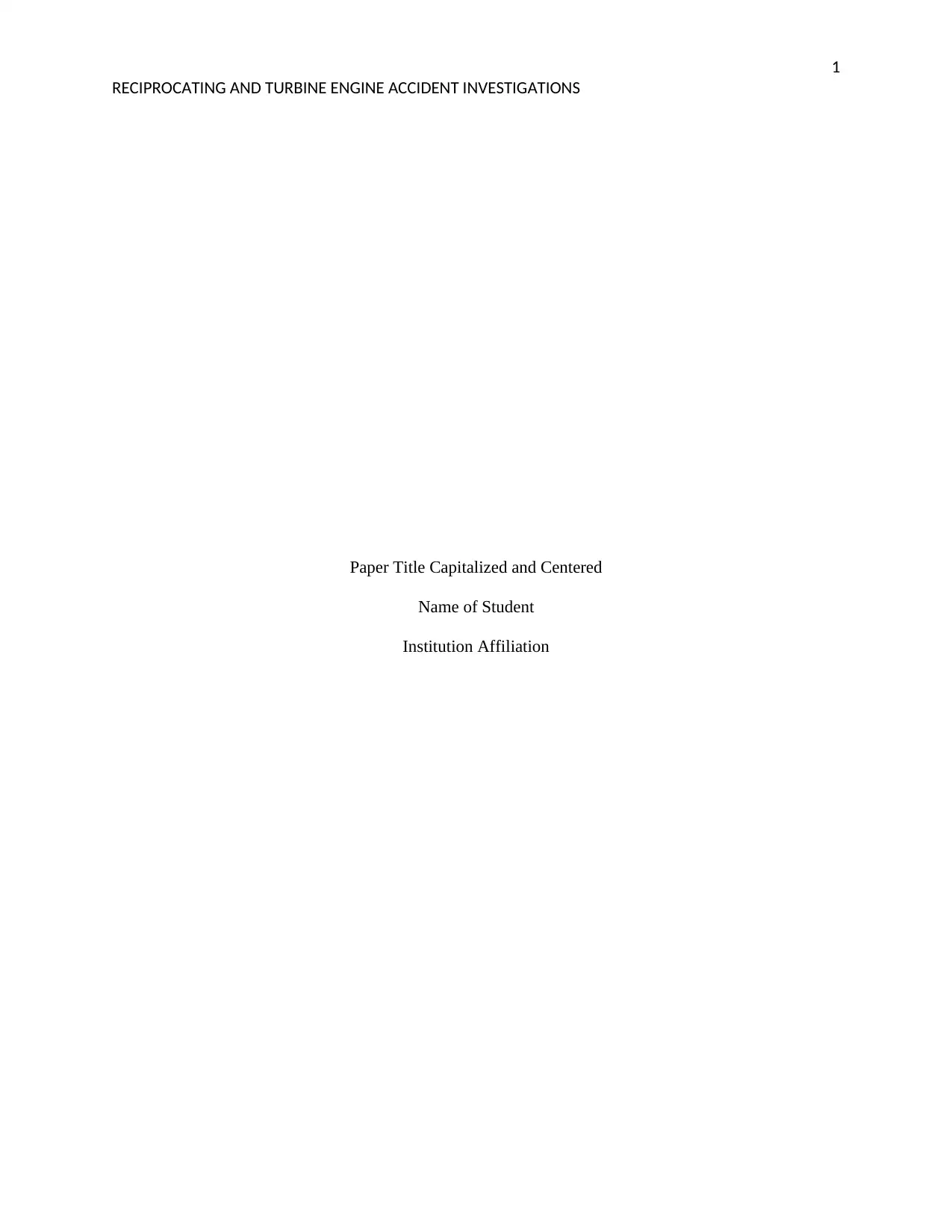
1
RECIPROCATING AND TURBINE ENGINE ACCIDENT INVESTIGATIONS
Paper Title Capitalized and Centered
Name of Student
Institution Affiliation
RECIPROCATING AND TURBINE ENGINE ACCIDENT INVESTIGATIONS
Paper Title Capitalized and Centered
Name of Student
Institution Affiliation
Paraphrase This Document
Need a fresh take? Get an instant paraphrase of this document with our AI Paraphraser
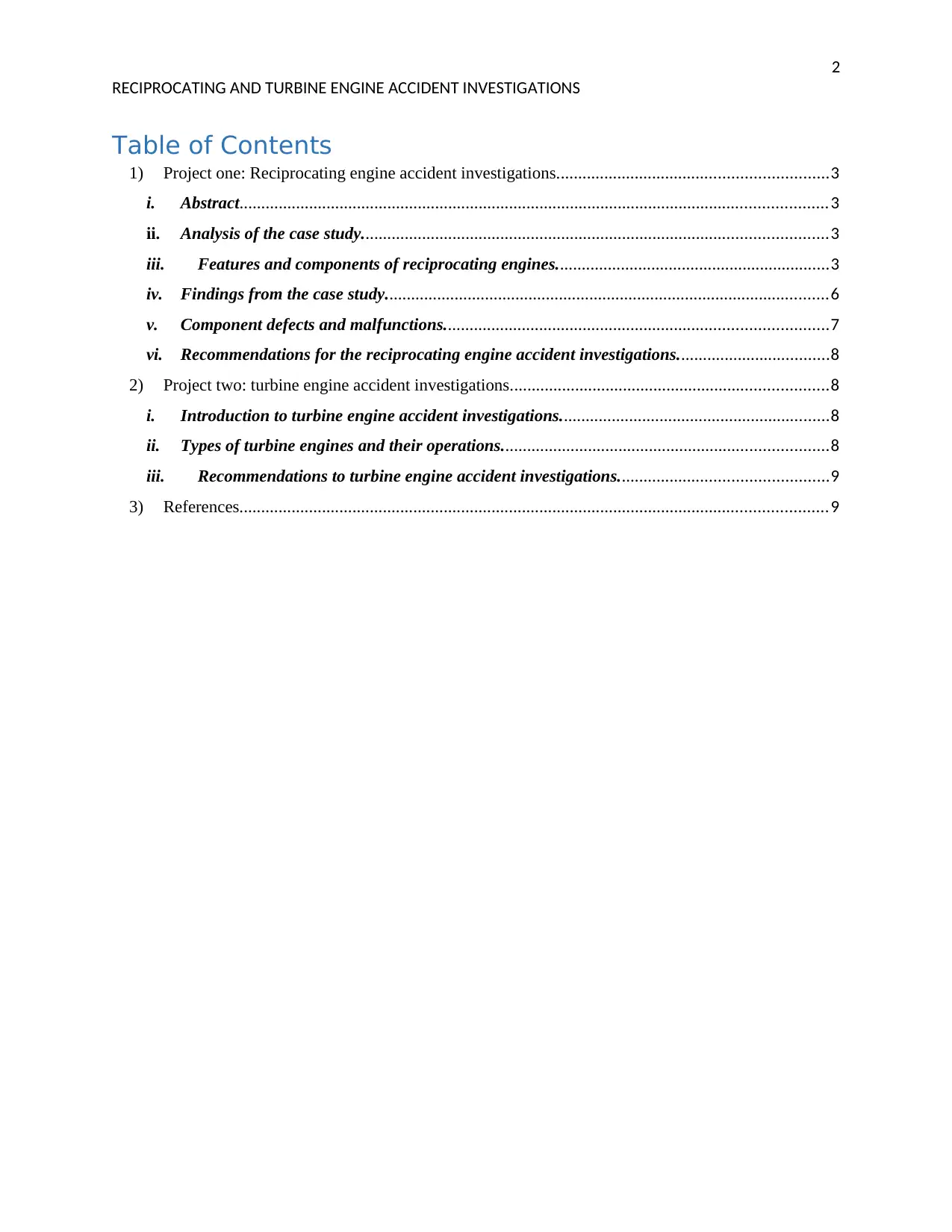
2
RECIPROCATING AND TURBINE ENGINE ACCIDENT INVESTIGATIONS
Table of Contents
1) Project one: Reciprocating engine accident investigations..............................................................3
i. Abstract.......................................................................................................................................3
ii. Analysis of the case study...........................................................................................................3
iii. Features and components of reciprocating engines...............................................................3
iv. Findings from the case study......................................................................................................6
v. Component defects and malfunctions........................................................................................7
vi. Recommendations for the reciprocating engine accident investigations...................................8
2) Project two: turbine engine accident investigations.........................................................................8
i. Introduction to turbine engine accident investigations..............................................................8
ii. Types of turbine engines and their operations...........................................................................8
iii. Recommendations to turbine engine accident investigations................................................9
3) References.......................................................................................................................................9
RECIPROCATING AND TURBINE ENGINE ACCIDENT INVESTIGATIONS
Table of Contents
1) Project one: Reciprocating engine accident investigations..............................................................3
i. Abstract.......................................................................................................................................3
ii. Analysis of the case study...........................................................................................................3
iii. Features and components of reciprocating engines...............................................................3
iv. Findings from the case study......................................................................................................6
v. Component defects and malfunctions........................................................................................7
vi. Recommendations for the reciprocating engine accident investigations...................................8
2) Project two: turbine engine accident investigations.........................................................................8
i. Introduction to turbine engine accident investigations..............................................................8
ii. Types of turbine engines and their operations...........................................................................8
iii. Recommendations to turbine engine accident investigations................................................9
3) References.......................................................................................................................................9
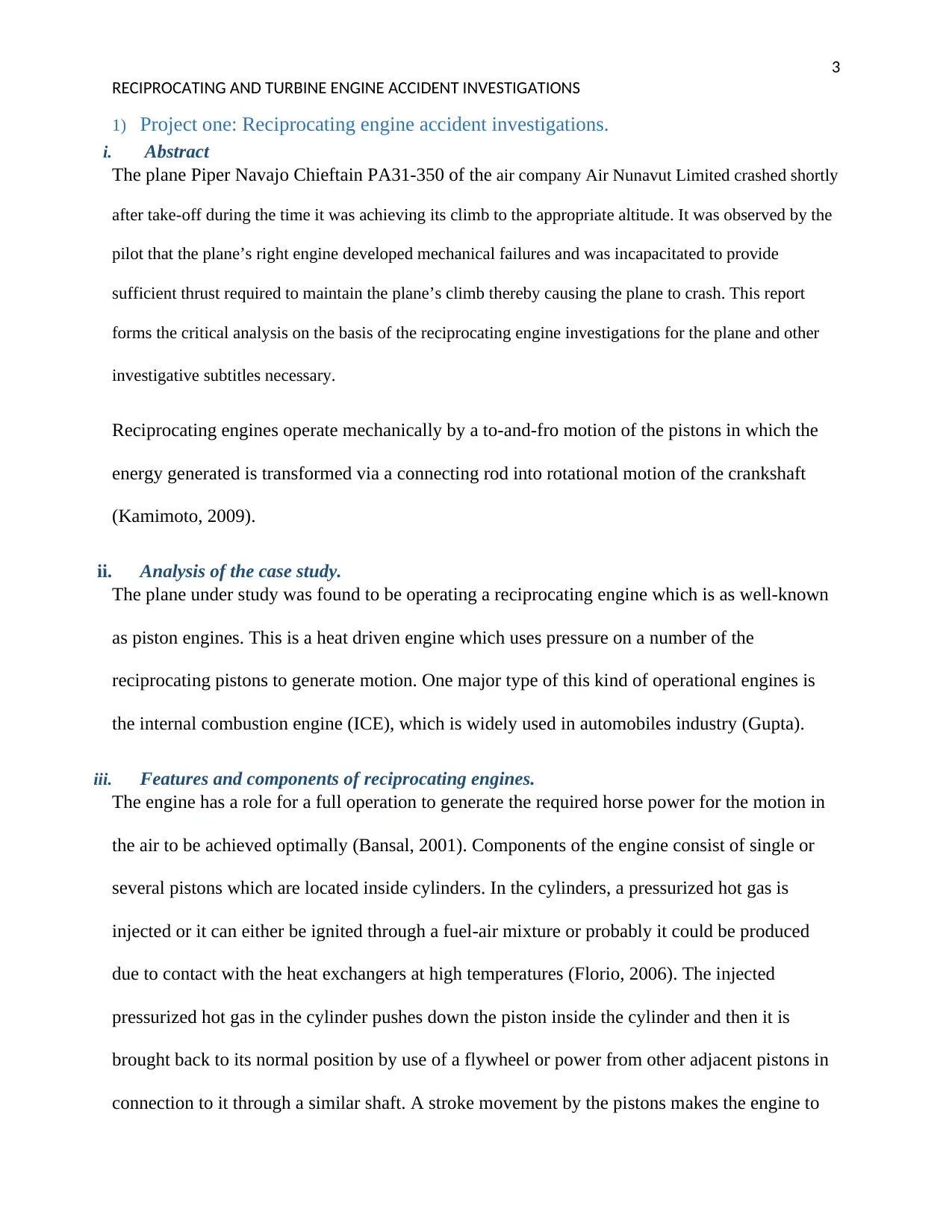
3
RECIPROCATING AND TURBINE ENGINE ACCIDENT INVESTIGATIONS
1) Project one: Reciprocating engine accident investigations.
i. Abstract
The plane Piper Navajo Chieftain PA31-350 of the air company Air Nunavut Limited crashed shortly
after take-off during the time it was achieving its climb to the appropriate altitude. It was observed by the
pilot that the plane’s right engine developed mechanical failures and was incapacitated to provide
sufficient thrust required to maintain the plane’s climb thereby causing the plane to crash. This report
forms the critical analysis on the basis of the reciprocating engine investigations for the plane and other
investigative subtitles necessary.
Reciprocating engines operate mechanically by a to-and-fro motion of the pistons in which the
energy generated is transformed via a connecting rod into rotational motion of the crankshaft
(Kamimoto, 2009).
ii. Analysis of the case study.
The plane under study was found to be operating a reciprocating engine which is as well-known
as piston engines. This is a heat driven engine which uses pressure on a number of the
reciprocating pistons to generate motion. One major type of this kind of operational engines is
the internal combustion engine (ICE), which is widely used in automobiles industry (Gupta).
iii. Features and components of reciprocating engines.
The engine has a role for a full operation to generate the required horse power for the motion in
the air to be achieved optimally (Bansal, 2001). Components of the engine consist of single or
several pistons which are located inside cylinders. In the cylinders, a pressurized hot gas is
injected or it can either be ignited through a fuel-air mixture or probably it could be produced
due to contact with the heat exchangers at high temperatures (Florio, 2006). The injected
pressurized hot gas in the cylinder pushes down the piston inside the cylinder and then it is
brought back to its normal position by use of a flywheel or power from other adjacent pistons in
connection to it through a similar shaft. A stroke movement by the pistons makes the engine to
RECIPROCATING AND TURBINE ENGINE ACCIDENT INVESTIGATIONS
1) Project one: Reciprocating engine accident investigations.
i. Abstract
The plane Piper Navajo Chieftain PA31-350 of the air company Air Nunavut Limited crashed shortly
after take-off during the time it was achieving its climb to the appropriate altitude. It was observed by the
pilot that the plane’s right engine developed mechanical failures and was incapacitated to provide
sufficient thrust required to maintain the plane’s climb thereby causing the plane to crash. This report
forms the critical analysis on the basis of the reciprocating engine investigations for the plane and other
investigative subtitles necessary.
Reciprocating engines operate mechanically by a to-and-fro motion of the pistons in which the
energy generated is transformed via a connecting rod into rotational motion of the crankshaft
(Kamimoto, 2009).
ii. Analysis of the case study.
The plane under study was found to be operating a reciprocating engine which is as well-known
as piston engines. This is a heat driven engine which uses pressure on a number of the
reciprocating pistons to generate motion. One major type of this kind of operational engines is
the internal combustion engine (ICE), which is widely used in automobiles industry (Gupta).
iii. Features and components of reciprocating engines.
The engine has a role for a full operation to generate the required horse power for the motion in
the air to be achieved optimally (Bansal, 2001). Components of the engine consist of single or
several pistons which are located inside cylinders. In the cylinders, a pressurized hot gas is
injected or it can either be ignited through a fuel-air mixture or probably it could be produced
due to contact with the heat exchangers at high temperatures (Florio, 2006). The injected
pressurized hot gas in the cylinder pushes down the piston inside the cylinder and then it is
brought back to its normal position by use of a flywheel or power from other adjacent pistons in
connection to it through a similar shaft. A stroke movement by the pistons makes the engine to
⊘ This is a preview!⊘
Do you want full access?
Subscribe today to unlock all pages.

Trusted by 1+ million students worldwide
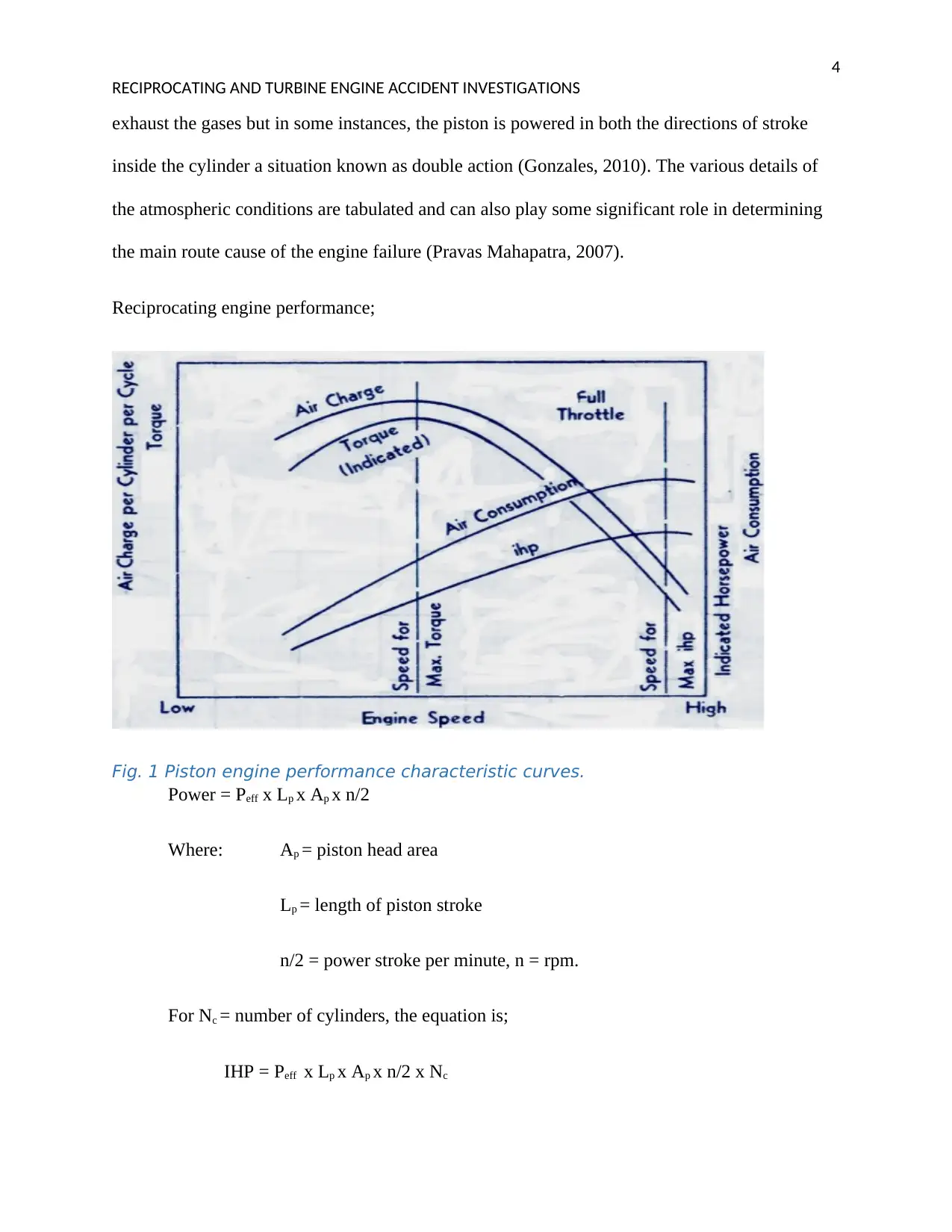
4
RECIPROCATING AND TURBINE ENGINE ACCIDENT INVESTIGATIONS
exhaust the gases but in some instances, the piston is powered in both the directions of stroke
inside the cylinder a situation known as double action (Gonzales, 2010). The various details of
the atmospheric conditions are tabulated and can also play some significant role in determining
the main route cause of the engine failure (Pravas Mahapatra, 2007).
Reciprocating engine performance;
Fig. 1 Piston engine performance characteristic curves.
Power = Peff x Lp x Ap x n/2
Where: Ap = piston head area
Lp = length of piston stroke
n/2 = power stroke per minute, n = rpm.
For Nc = number of cylinders, the equation is;
IHP = Peff x Lp x Ap x n/2 x Nc
RECIPROCATING AND TURBINE ENGINE ACCIDENT INVESTIGATIONS
exhaust the gases but in some instances, the piston is powered in both the directions of stroke
inside the cylinder a situation known as double action (Gonzales, 2010). The various details of
the atmospheric conditions are tabulated and can also play some significant role in determining
the main route cause of the engine failure (Pravas Mahapatra, 2007).
Reciprocating engine performance;
Fig. 1 Piston engine performance characteristic curves.
Power = Peff x Lp x Ap x n/2
Where: Ap = piston head area
Lp = length of piston stroke
n/2 = power stroke per minute, n = rpm.
For Nc = number of cylinders, the equation is;
IHP = Peff x Lp x Ap x n/2 x Nc
Paraphrase This Document
Need a fresh take? Get an instant paraphrase of this document with our AI Paraphraser
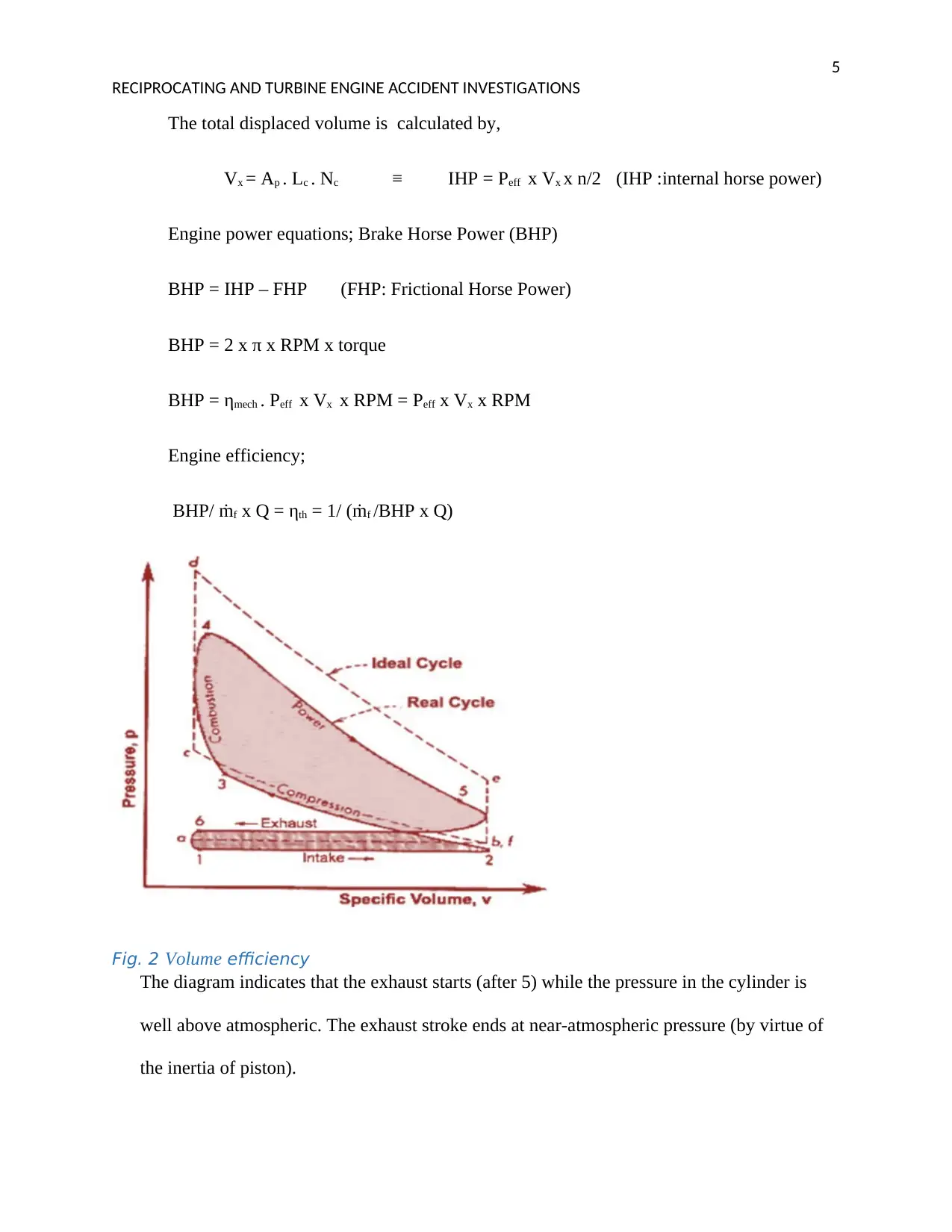
5
RECIPROCATING AND TURBINE ENGINE ACCIDENT INVESTIGATIONS
The total displaced volume is calculated by,
Vx = Ap . Lc . Nc ≡ IHP = Peff x Vx x n/2 (IHP :internal horse power)
Engine power equations; Brake Horse Power (BHP)
BHP = IHP – FHP (FHP: Frictional Horse Power)
BHP = 2 x π x RPM x torque
BHP = ηmech . Peff x Vx x RPM = Peff x Vx x RPM
Engine efficiency;
BHP/ ṁf x Q = ηth = 1/ (ṁf /BHP x Q)
Fig. 2 Volume efficiency
The diagram indicates that the exhaust starts (after 5) while the pressure in the cylinder is
well above atmospheric. The exhaust stroke ends at near-atmospheric pressure (by virtue of
the inertia of piston).
RECIPROCATING AND TURBINE ENGINE ACCIDENT INVESTIGATIONS
The total displaced volume is calculated by,
Vx = Ap . Lc . Nc ≡ IHP = Peff x Vx x n/2 (IHP :internal horse power)
Engine power equations; Brake Horse Power (BHP)
BHP = IHP – FHP (FHP: Frictional Horse Power)
BHP = 2 x π x RPM x torque
BHP = ηmech . Peff x Vx x RPM = Peff x Vx x RPM
Engine efficiency;
BHP/ ṁf x Q = ηth = 1/ (ṁf /BHP x Q)
Fig. 2 Volume efficiency
The diagram indicates that the exhaust starts (after 5) while the pressure in the cylinder is
well above atmospheric. The exhaust stroke ends at near-atmospheric pressure (by virtue of
the inertia of piston).
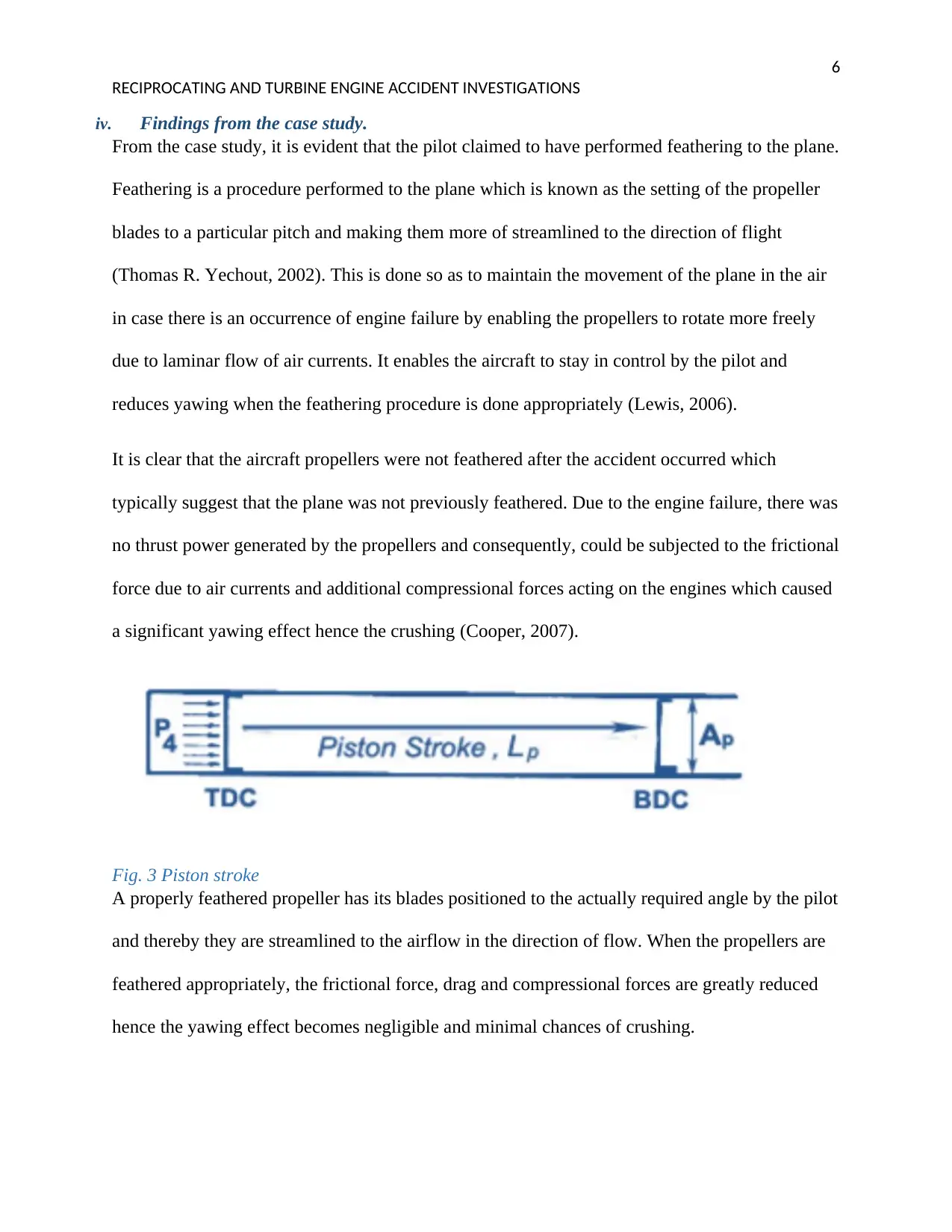
6
RECIPROCATING AND TURBINE ENGINE ACCIDENT INVESTIGATIONS
iv. Findings from the case study.
From the case study, it is evident that the pilot claimed to have performed feathering to the plane.
Feathering is a procedure performed to the plane which is known as the setting of the propeller
blades to a particular pitch and making them more of streamlined to the direction of flight
(Thomas R. Yechout, 2002). This is done so as to maintain the movement of the plane in the air
in case there is an occurrence of engine failure by enabling the propellers to rotate more freely
due to laminar flow of air currents. It enables the aircraft to stay in control by the pilot and
reduces yawing when the feathering procedure is done appropriately (Lewis, 2006).
It is clear that the aircraft propellers were not feathered after the accident occurred which
typically suggest that the plane was not previously feathered. Due to the engine failure, there was
no thrust power generated by the propellers and consequently, could be subjected to the frictional
force due to air currents and additional compressional forces acting on the engines which caused
a significant yawing effect hence the crushing (Cooper, 2007).
Fig. 3 Piston stroke
A properly feathered propeller has its blades positioned to the actually required angle by the pilot
and thereby they are streamlined to the airflow in the direction of flow. When the propellers are
feathered appropriately, the frictional force, drag and compressional forces are greatly reduced
hence the yawing effect becomes negligible and minimal chances of crushing.
RECIPROCATING AND TURBINE ENGINE ACCIDENT INVESTIGATIONS
iv. Findings from the case study.
From the case study, it is evident that the pilot claimed to have performed feathering to the plane.
Feathering is a procedure performed to the plane which is known as the setting of the propeller
blades to a particular pitch and making them more of streamlined to the direction of flight
(Thomas R. Yechout, 2002). This is done so as to maintain the movement of the plane in the air
in case there is an occurrence of engine failure by enabling the propellers to rotate more freely
due to laminar flow of air currents. It enables the aircraft to stay in control by the pilot and
reduces yawing when the feathering procedure is done appropriately (Lewis, 2006).
It is clear that the aircraft propellers were not feathered after the accident occurred which
typically suggest that the plane was not previously feathered. Due to the engine failure, there was
no thrust power generated by the propellers and consequently, could be subjected to the frictional
force due to air currents and additional compressional forces acting on the engines which caused
a significant yawing effect hence the crushing (Cooper, 2007).
Fig. 3 Piston stroke
A properly feathered propeller has its blades positioned to the actually required angle by the pilot
and thereby they are streamlined to the airflow in the direction of flow. When the propellers are
feathered appropriately, the frictional force, drag and compressional forces are greatly reduced
hence the yawing effect becomes negligible and minimal chances of crushing.
⊘ This is a preview!⊘
Do you want full access?
Subscribe today to unlock all pages.

Trusted by 1+ million students worldwide
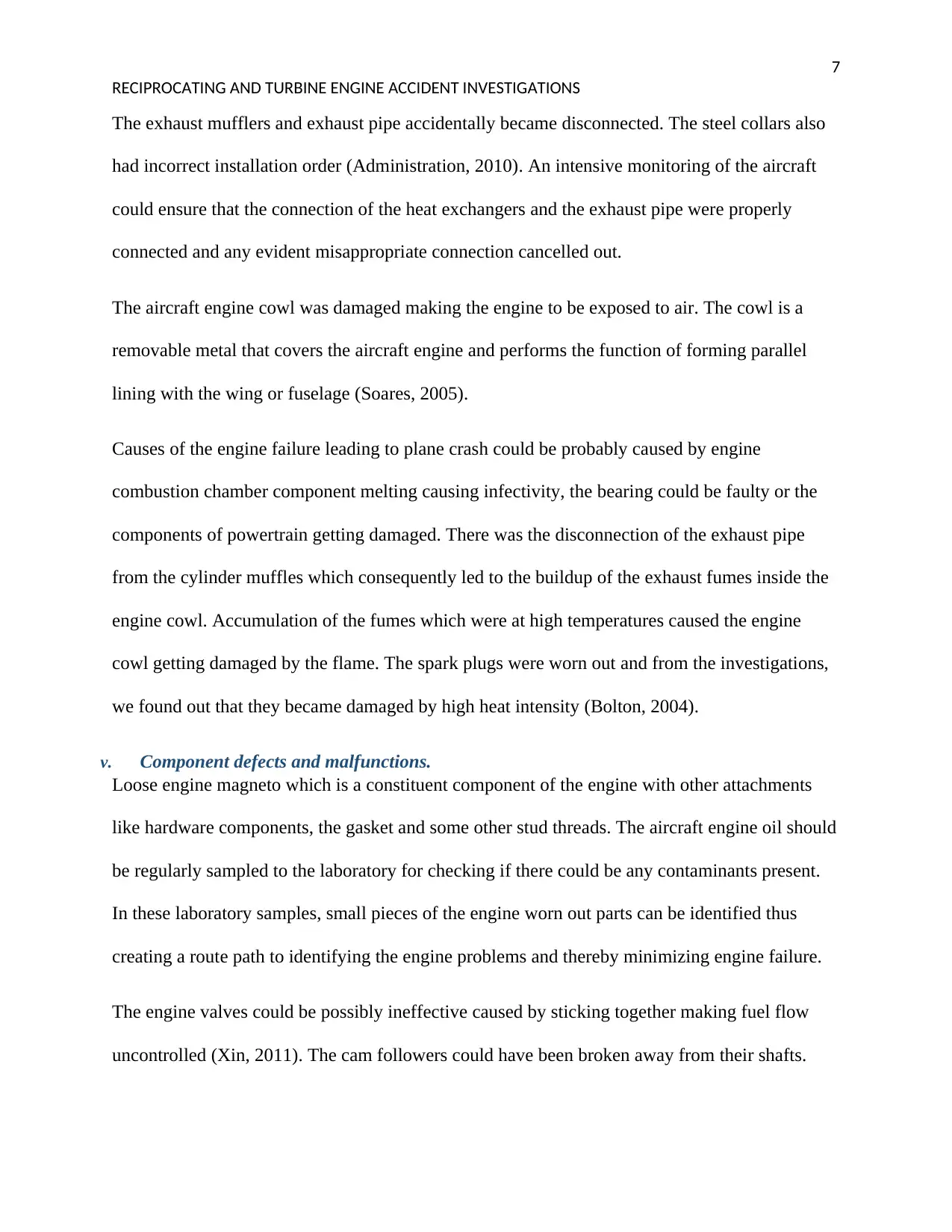
7
RECIPROCATING AND TURBINE ENGINE ACCIDENT INVESTIGATIONS
The exhaust mufflers and exhaust pipe accidentally became disconnected. The steel collars also
had incorrect installation order (Administration, 2010). An intensive monitoring of the aircraft
could ensure that the connection of the heat exchangers and the exhaust pipe were properly
connected and any evident misappropriate connection cancelled out.
The aircraft engine cowl was damaged making the engine to be exposed to air. The cowl is a
removable metal that covers the aircraft engine and performs the function of forming parallel
lining with the wing or fuselage (Soares, 2005).
Causes of the engine failure leading to plane crash could be probably caused by engine
combustion chamber component melting causing infectivity, the bearing could be faulty or the
components of powertrain getting damaged. There was the disconnection of the exhaust pipe
from the cylinder muffles which consequently led to the buildup of the exhaust fumes inside the
engine cowl. Accumulation of the fumes which were at high temperatures caused the engine
cowl getting damaged by the flame. The spark plugs were worn out and from the investigations,
we found out that they became damaged by high heat intensity (Bolton, 2004).
v. Component defects and malfunctions.
Loose engine magneto which is a constituent component of the engine with other attachments
like hardware components, the gasket and some other stud threads. The aircraft engine oil should
be regularly sampled to the laboratory for checking if there could be any contaminants present.
In these laboratory samples, small pieces of the engine worn out parts can be identified thus
creating a route path to identifying the engine problems and thereby minimizing engine failure.
The engine valves could be possibly ineffective caused by sticking together making fuel flow
uncontrolled (Xin, 2011). The cam followers could have been broken away from their shafts.
RECIPROCATING AND TURBINE ENGINE ACCIDENT INVESTIGATIONS
The exhaust mufflers and exhaust pipe accidentally became disconnected. The steel collars also
had incorrect installation order (Administration, 2010). An intensive monitoring of the aircraft
could ensure that the connection of the heat exchangers and the exhaust pipe were properly
connected and any evident misappropriate connection cancelled out.
The aircraft engine cowl was damaged making the engine to be exposed to air. The cowl is a
removable metal that covers the aircraft engine and performs the function of forming parallel
lining with the wing or fuselage (Soares, 2005).
Causes of the engine failure leading to plane crash could be probably caused by engine
combustion chamber component melting causing infectivity, the bearing could be faulty or the
components of powertrain getting damaged. There was the disconnection of the exhaust pipe
from the cylinder muffles which consequently led to the buildup of the exhaust fumes inside the
engine cowl. Accumulation of the fumes which were at high temperatures caused the engine
cowl getting damaged by the flame. The spark plugs were worn out and from the investigations,
we found out that they became damaged by high heat intensity (Bolton, 2004).
v. Component defects and malfunctions.
Loose engine magneto which is a constituent component of the engine with other attachments
like hardware components, the gasket and some other stud threads. The aircraft engine oil should
be regularly sampled to the laboratory for checking if there could be any contaminants present.
In these laboratory samples, small pieces of the engine worn out parts can be identified thus
creating a route path to identifying the engine problems and thereby minimizing engine failure.
The engine valves could be possibly ineffective caused by sticking together making fuel flow
uncontrolled (Xin, 2011). The cam followers could have been broken away from their shafts.
Paraphrase This Document
Need a fresh take? Get an instant paraphrase of this document with our AI Paraphraser
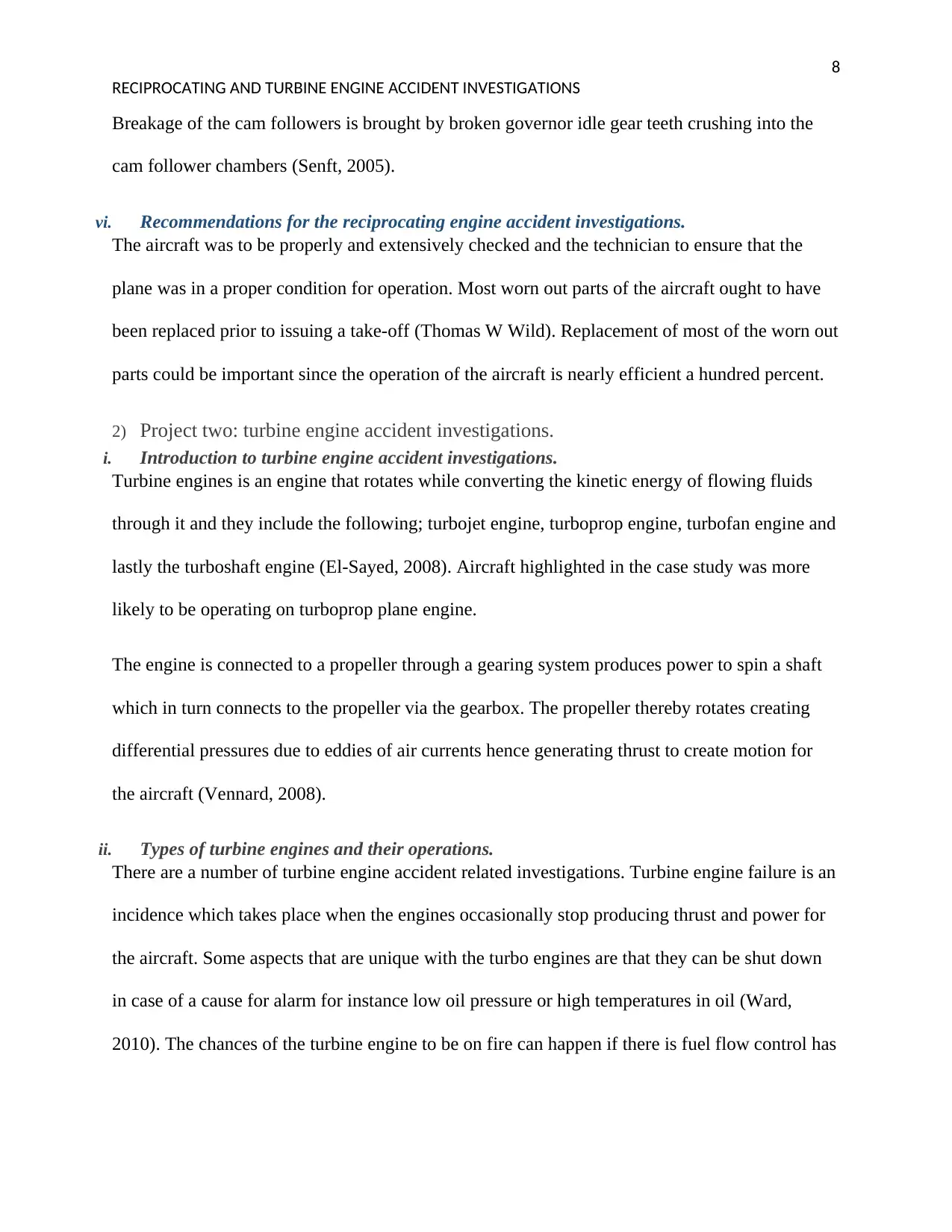
8
RECIPROCATING AND TURBINE ENGINE ACCIDENT INVESTIGATIONS
Breakage of the cam followers is brought by broken governor idle gear teeth crushing into the
cam follower chambers (Senft, 2005).
vi. Recommendations for the reciprocating engine accident investigations.
The aircraft was to be properly and extensively checked and the technician to ensure that the
plane was in a proper condition for operation. Most worn out parts of the aircraft ought to have
been replaced prior to issuing a take-off (Thomas W Wild). Replacement of most of the worn out
parts could be important since the operation of the aircraft is nearly efficient a hundred percent.
2) Project two: turbine engine accident investigations.
i. Introduction to turbine engine accident investigations.
Turbine engines is an engine that rotates while converting the kinetic energy of flowing fluids
through it and they include the following; turbojet engine, turboprop engine, turbofan engine and
lastly the turboshaft engine (El-Sayed, 2008). Aircraft highlighted in the case study was more
likely to be operating on turboprop plane engine.
The engine is connected to a propeller through a gearing system produces power to spin a shaft
which in turn connects to the propeller via the gearbox. The propeller thereby rotates creating
differential pressures due to eddies of air currents hence generating thrust to create motion for
the aircraft (Vennard, 2008).
ii. Types of turbine engines and their operations.
There are a number of turbine engine accident related investigations. Turbine engine failure is an
incidence which takes place when the engines occasionally stop producing thrust and power for
the aircraft. Some aspects that are unique with the turbo engines are that they can be shut down
in case of a cause for alarm for instance low oil pressure or high temperatures in oil (Ward,
2010). The chances of the turbine engine to be on fire can happen if there is fuel flow control has
RECIPROCATING AND TURBINE ENGINE ACCIDENT INVESTIGATIONS
Breakage of the cam followers is brought by broken governor idle gear teeth crushing into the
cam follower chambers (Senft, 2005).
vi. Recommendations for the reciprocating engine accident investigations.
The aircraft was to be properly and extensively checked and the technician to ensure that the
plane was in a proper condition for operation. Most worn out parts of the aircraft ought to have
been replaced prior to issuing a take-off (Thomas W Wild). Replacement of most of the worn out
parts could be important since the operation of the aircraft is nearly efficient a hundred percent.
2) Project two: turbine engine accident investigations.
i. Introduction to turbine engine accident investigations.
Turbine engines is an engine that rotates while converting the kinetic energy of flowing fluids
through it and they include the following; turbojet engine, turboprop engine, turbofan engine and
lastly the turboshaft engine (El-Sayed, 2008). Aircraft highlighted in the case study was more
likely to be operating on turboprop plane engine.
The engine is connected to a propeller through a gearing system produces power to spin a shaft
which in turn connects to the propeller via the gearbox. The propeller thereby rotates creating
differential pressures due to eddies of air currents hence generating thrust to create motion for
the aircraft (Vennard, 2008).
ii. Types of turbine engines and their operations.
There are a number of turbine engine accident related investigations. Turbine engine failure is an
incidence which takes place when the engines occasionally stop producing thrust and power for
the aircraft. Some aspects that are unique with the turbo engines are that they can be shut down
in case of a cause for alarm for instance low oil pressure or high temperatures in oil (Ward,
2010). The chances of the turbine engine to be on fire can happen if there is fuel flow control has
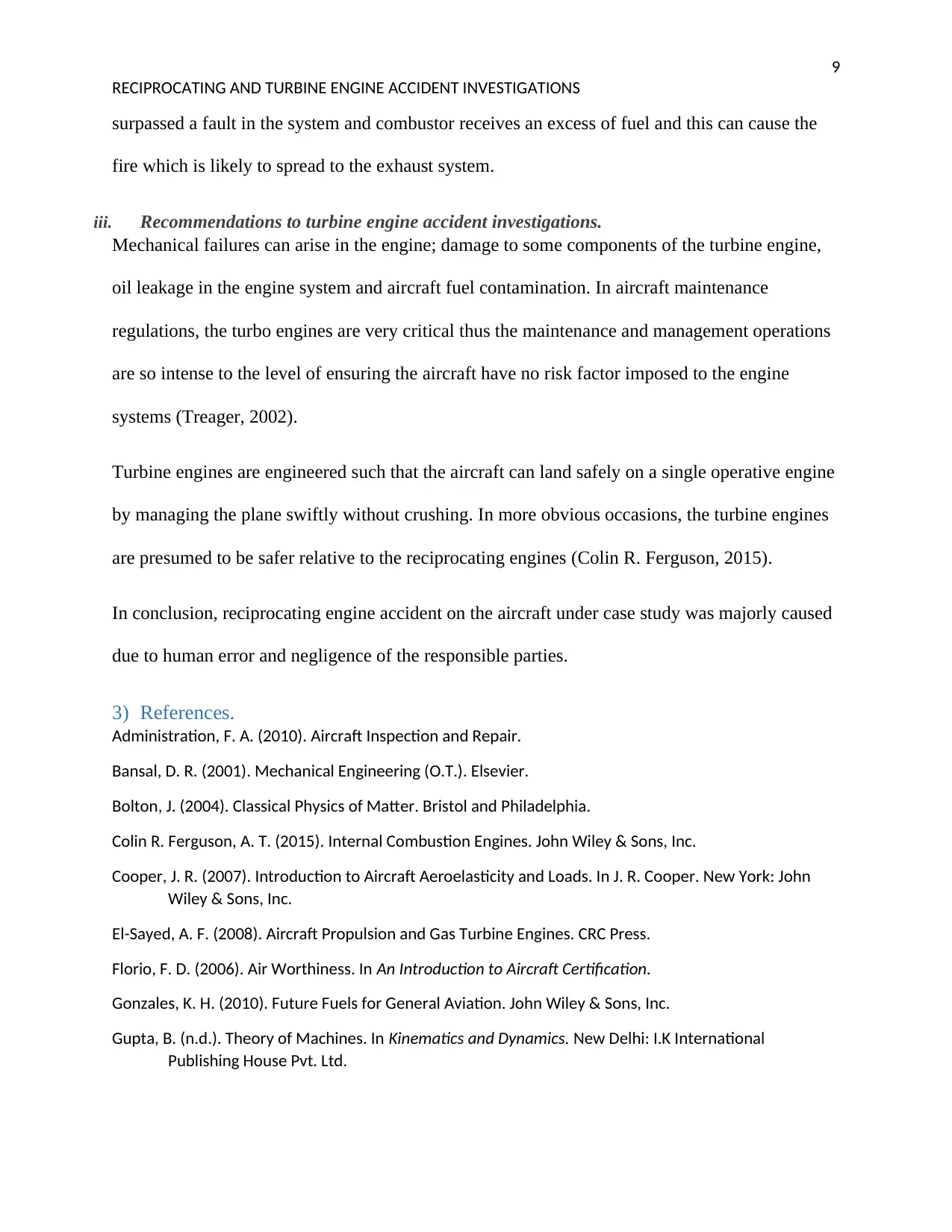
9
RECIPROCATING AND TURBINE ENGINE ACCIDENT INVESTIGATIONS
surpassed a fault in the system and combustor receives an excess of fuel and this can cause the
fire which is likely to spread to the exhaust system.
iii. Recommendations to turbine engine accident investigations.
Mechanical failures can arise in the engine; damage to some components of the turbine engine,
oil leakage in the engine system and aircraft fuel contamination. In aircraft maintenance
regulations, the turbo engines are very critical thus the maintenance and management operations
are so intense to the level of ensuring the aircraft have no risk factor imposed to the engine
systems (Treager, 2002).
Turbine engines are engineered such that the aircraft can land safely on a single operative engine
by managing the plane swiftly without crushing. In more obvious occasions, the turbine engines
are presumed to be safer relative to the reciprocating engines (Colin R. Ferguson, 2015).
In conclusion, reciprocating engine accident on the aircraft under case study was majorly caused
due to human error and negligence of the responsible parties.
3) References.
Administration, F. A. (2010). Aircraft Inspection and Repair.
Bansal, D. R. (2001). Mechanical Engineering (O.T.). Elsevier.
Bolton, J. (2004). Classical Physics of Matter. Bristol and Philadelphia.
Colin R. Ferguson, A. T. (2015). Internal Combustion Engines. John Wiley & Sons, Inc.
Cooper, J. R. (2007). Introduction to Aircraft Aeroelasticity and Loads. In J. R. Cooper. New York: John
Wiley & Sons, Inc.
El-Sayed, A. F. (2008). Aircraft Propulsion and Gas Turbine Engines. CRC Press.
Florio, F. D. (2006). Air Worthiness. In An Introduction to Aircraft Certification.
Gonzales, K. H. (2010). Future Fuels for General Aviation. John Wiley & Sons, Inc.
Gupta, B. (n.d.). Theory of Machines. In Kinematics and Dynamics. New Delhi: I.K International
Publishing House Pvt. Ltd.
RECIPROCATING AND TURBINE ENGINE ACCIDENT INVESTIGATIONS
surpassed a fault in the system and combustor receives an excess of fuel and this can cause the
fire which is likely to spread to the exhaust system.
iii. Recommendations to turbine engine accident investigations.
Mechanical failures can arise in the engine; damage to some components of the turbine engine,
oil leakage in the engine system and aircraft fuel contamination. In aircraft maintenance
regulations, the turbo engines are very critical thus the maintenance and management operations
are so intense to the level of ensuring the aircraft have no risk factor imposed to the engine
systems (Treager, 2002).
Turbine engines are engineered such that the aircraft can land safely on a single operative engine
by managing the plane swiftly without crushing. In more obvious occasions, the turbine engines
are presumed to be safer relative to the reciprocating engines (Colin R. Ferguson, 2015).
In conclusion, reciprocating engine accident on the aircraft under case study was majorly caused
due to human error and negligence of the responsible parties.
3) References.
Administration, F. A. (2010). Aircraft Inspection and Repair.
Bansal, D. R. (2001). Mechanical Engineering (O.T.). Elsevier.
Bolton, J. (2004). Classical Physics of Matter. Bristol and Philadelphia.
Colin R. Ferguson, A. T. (2015). Internal Combustion Engines. John Wiley & Sons, Inc.
Cooper, J. R. (2007). Introduction to Aircraft Aeroelasticity and Loads. In J. R. Cooper. New York: John
Wiley & Sons, Inc.
El-Sayed, A. F. (2008). Aircraft Propulsion and Gas Turbine Engines. CRC Press.
Florio, F. D. (2006). Air Worthiness. In An Introduction to Aircraft Certification.
Gonzales, K. H. (2010). Future Fuels for General Aviation. John Wiley & Sons, Inc.
Gupta, B. (n.d.). Theory of Machines. In Kinematics and Dynamics. New Delhi: I.K International
Publishing House Pvt. Ltd.
⊘ This is a preview!⊘
Do you want full access?
Subscribe today to unlock all pages.

Trusted by 1+ million students worldwide
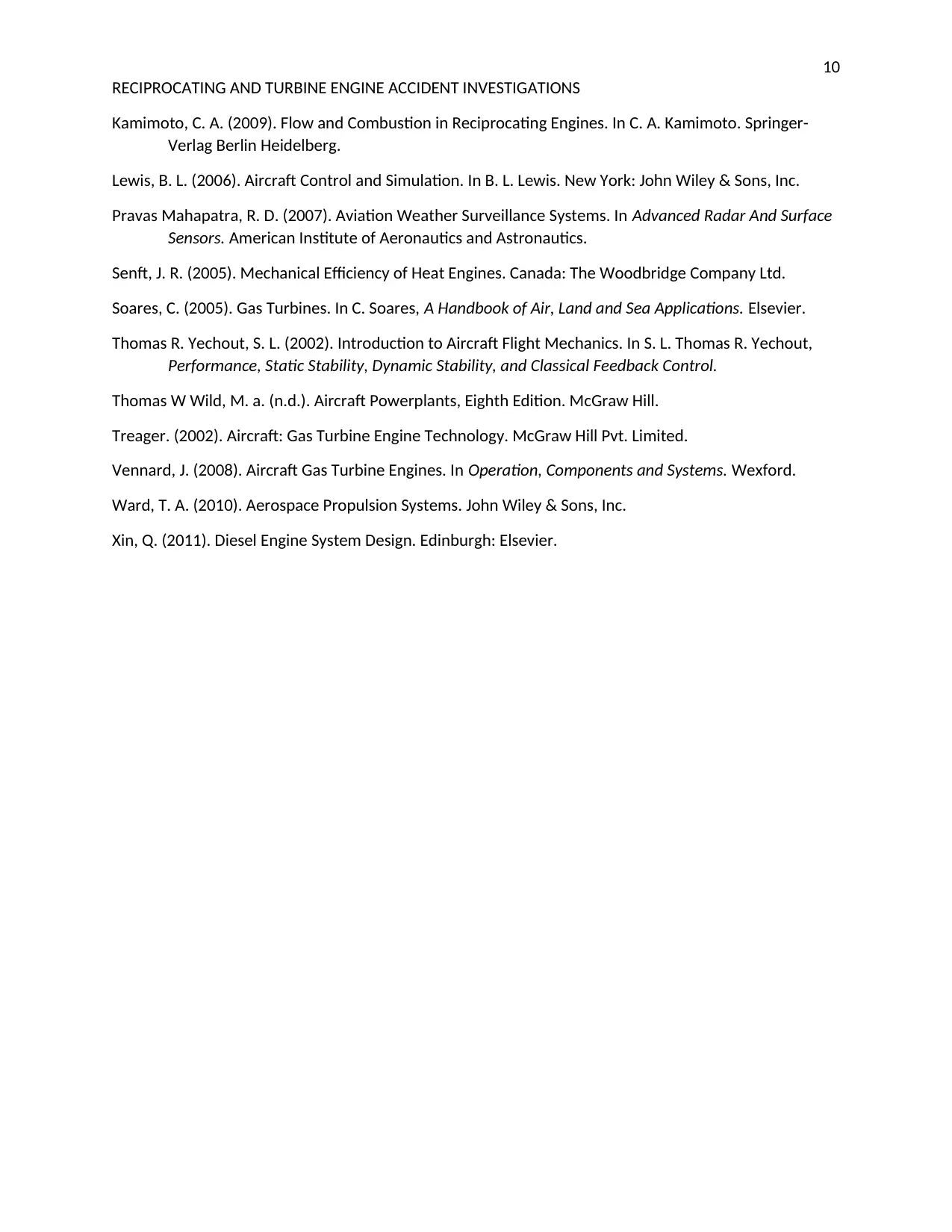
10
RECIPROCATING AND TURBINE ENGINE ACCIDENT INVESTIGATIONS
Kamimoto, C. A. (2009). Flow and Combustion in Reciprocating Engines. In C. A. Kamimoto. Springer-
Verlag Berlin Heidelberg.
Lewis, B. L. (2006). Aircraft Control and Simulation. In B. L. Lewis. New York: John Wiley & Sons, Inc.
Pravas Mahapatra, R. D. (2007). Aviation Weather Surveillance Systems. In Advanced Radar And Surface
Sensors. American Institute of Aeronautics and Astronautics.
Senft, J. R. (2005). Mechanical Efficiency of Heat Engines. Canada: The Woodbridge Company Ltd.
Soares, C. (2005). Gas Turbines. In C. Soares, A Handbook of Air, Land and Sea Applications. Elsevier.
Thomas R. Yechout, S. L. (2002). Introduction to Aircraft Flight Mechanics. In S. L. Thomas R. Yechout,
Performance, Static Stability, Dynamic Stability, and Classical Feedback Control.
Thomas W Wild, M. a. (n.d.). Aircraft Powerplants, Eighth Edition. McGraw Hill.
Treager. (2002). Aircraft: Gas Turbine Engine Technology. McGraw Hill Pvt. Limited.
Vennard, J. (2008). Aircraft Gas Turbine Engines. In Operation, Components and Systems. Wexford.
Ward, T. A. (2010). Aerospace Propulsion Systems. John Wiley & Sons, Inc.
Xin, Q. (2011). Diesel Engine System Design. Edinburgh: Elsevier.
RECIPROCATING AND TURBINE ENGINE ACCIDENT INVESTIGATIONS
Kamimoto, C. A. (2009). Flow and Combustion in Reciprocating Engines. In C. A. Kamimoto. Springer-
Verlag Berlin Heidelberg.
Lewis, B. L. (2006). Aircraft Control and Simulation. In B. L. Lewis. New York: John Wiley & Sons, Inc.
Pravas Mahapatra, R. D. (2007). Aviation Weather Surveillance Systems. In Advanced Radar And Surface
Sensors. American Institute of Aeronautics and Astronautics.
Senft, J. R. (2005). Mechanical Efficiency of Heat Engines. Canada: The Woodbridge Company Ltd.
Soares, C. (2005). Gas Turbines. In C. Soares, A Handbook of Air, Land and Sea Applications. Elsevier.
Thomas R. Yechout, S. L. (2002). Introduction to Aircraft Flight Mechanics. In S. L. Thomas R. Yechout,
Performance, Static Stability, Dynamic Stability, and Classical Feedback Control.
Thomas W Wild, M. a. (n.d.). Aircraft Powerplants, Eighth Edition. McGraw Hill.
Treager. (2002). Aircraft: Gas Turbine Engine Technology. McGraw Hill Pvt. Limited.
Vennard, J. (2008). Aircraft Gas Turbine Engines. In Operation, Components and Systems. Wexford.
Ward, T. A. (2010). Aerospace Propulsion Systems. John Wiley & Sons, Inc.
Xin, Q. (2011). Diesel Engine System Design. Edinburgh: Elsevier.
1 out of 10
Related Documents
Your All-in-One AI-Powered Toolkit for Academic Success.
+13062052269
info@desklib.com
Available 24*7 on WhatsApp / Email
![[object Object]](/_next/static/media/star-bottom.7253800d.svg)
Unlock your academic potential
Copyright © 2020–2025 A2Z Services. All Rights Reserved. Developed and managed by ZUCOL.





